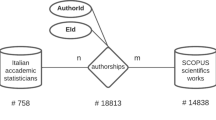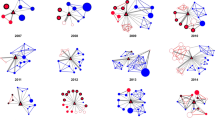Abstract
The field of higher education research is fast-growing, both in number of publications and in geographical reach. There is however limited evidence on how this growth in publication influences the structure of the underlying co-authorship network. This is important as structural network parameters can change quickly in a fast-growing network, leading to fundamental different network structures, e.g., in terms of hierarchy, fragmentation, and inequality. Ultimately, these network structures can influence the current and future innovation and knowledge production in the field. Empirically, we construct 34 different co-authorship networks of all authors published in 28 higher education journals listed in Web of Science between 1976 and 2018 and perform bibliometric network analyses. We find that the growth of publications and authors in the higher education research field leads to increased clustering among authors, creating a dense core of well-connected author clusters. At the same time, we observe an increasing inequality in the network. The co-authorship network is characterized by high fragmentation and reveals a core-periphery structure. Our analysis shows that co-authorship is a selective process, driven by a Matthew effect based on previous publications. As a result, core authors are unlikely to co-author with newer, less established authors. Moreover, we also detect a growing inequality in the average impact of an article. We conclude the paper by discussing possible explanations and by offering some suggestions for future research.






Similar content being viewed by others
References
Albert, R., & Barabási, A.-L. (2002). Statistical mechanics of complex networks. Reviews of Modern Physics, 74(1), 47.
Barabási, A.-L., & Albert, R. (1999). Emergence of scaling in random networks. Science, 286(5439), 509–512.
Barabási, A.-L., Jeong, H., Néda, Z., Ravasz, E., Schubert, A., & Vicsek, T. (2002). Evolution of the social network of scientific collaborations. Physica A: Statistical Mechanics and its Applications, 311(3), 590–614. https://doi.org/10.1016/S0378-4371(02)00736-7.
Blondel, V. D., Guillaume, J.-L., Lambiotte, R., & Lefebvre, E. (2008). Fast unfolding of communities in large networks. Journal of Statistical Mechanics: Theory and Experiment, 2008(10), P10008. https://doi.org/10.1088/1742-5468/2008/10/P10008.
Boudreau, K. J., Brady, T., Ganguli, I., Gaule, P., Guinan, E., Hollenberg, A., & Lakhani, K. R. (2017). A field experiment on search costs and the formation of scientific collaborations. Review of Economics and Statistics, 99(4), 565–576.
Budd, J. M., & Magnuson, L. (2010). Higher education literature revisited: Citation patterns examined. Research in Higher Education, 51(3), 294–304. https://doi.org/10.1007/s11162-009-9155-6.
Burt, R. S. (1992). Structural holes: The social structure of competition. Cambridge: Harvard University Press.
Calma, A., & Davies, M. (2014). Studies in higher education 1976–2013: A retrospective using citation network analysis. Studies in Higher Education, 40(1), 4–21. https://doi.org/10.1080/03075079.2014.977858.
Calma, A., & Davies, M. (2017). Geographies of influence: A citation network analysis of Higher Education 1972–2014. Scientometrics, 110, 1579–1599. https://doi.org/10.1007/s11192-016-2228-3.
Cantwell, B., Marginson, S., & Smolentseva, A. (2018). High participation systems of higher education. Oxford University Press.
Cowan, R., & Jonard, N. (2003). The dynamics of collective invention. Journal of Economic Behavior & Organization, 52(4), 513–532. https://doi.org/10.1016/S0167-2681(03)00091-X.
Crespo, J., Suire, R., & Vicente, J. (2013). Assortativity and hierarchy in localized R&D collaboration networks. In T. Scherngell (Ed.), The geography of networks and R&D collaborations (pp. 115–128). Cham: Springer International Publishing. https://doi.org/10.1007/978-3-319-02699-2_7.
Daenekindt, S., & Huisman, J. (2020) Map** the scattered field of research on higher education. A correlated topic model of 17,000 articles, 1991-2018. High Education. https://doi.org/10.1007/s10734-020-00500-x.
Ebadi, A., & Schiffauerova, A. (2015). On the relation between the small world structure and scientific activities. PLoS One, 10(3), e0121129–e0121129. https://doi.org/10.1371/journal.pone.0121129.
Fleming, L., King, C., & Juda, A. I. (2007a). Small worlds and regional innovation. Organization Science, 18(6), 938–954. https://doi.org/10.1287/orsc.1070.0289.
Fleming, L., Mingo, S., & Chen, D. (2007b). Collaborative brokerage, generative creativity, and creative success. Administrative Science Quarterly, 52(3), 443–475. https://doi.org/10.2189/asqu.52.3.443.
Gazni, A., & Didegah, F. (2011). Investigating different types of research collaboration and citation impact: A case study of Harvard University’s publications. Scientometrics, 87(2), 251–265.
Granovetter, M. (1983). The strength of weak ties: A network theory revisited. Sociological Theory, 1, 201–233.
Gurzki, H., & Woisetschlaeger, D. M. (2017). Map** the luxury research landscape: A bibliometric citation analysis. Journal of Business Research, 77, 147–166.
Humphries, M. D., & Gurney, K. (2008). Network ‘small-world-ness’: A quantitative method for determining canonical network equivalence. PLoS One, 3(4), e0002051. https://doi.org/10.1371/journal.pone.0002051.
Jung, J., & Horta, H. (2013). Higher education research in Asia: A publication and co-publication analysis. Higher Education Quarterly, 67(4), 398–419.
Jung, J., Horta, H., & Yonezawa, A. (2018). Introduction: Higher education research as a field of study in Asia, In Researching Higher Education in Asia (pp. 1–11). Singapore: Springer.
Kandlbinder, P. (2012). Recognition and influence: The evolution of higher education research and development. Higher Education Research and Development, 31(1), 5–13. https://doi.org/10.1080/07294360.2012.642836.
Katz, J. S., & Martin, B. R. (1997). What is research collaboration? Research Policy, 26(1), 1–18.
Kim, Y., Horta, H., & Jung, J. (2017). Higher education research in Hong Kong, Japan, China, and Malaysia: Exploring research community cohesion and the integration of thematic approaches. Studies in Higher Education, 42(1), 149–168.
Kosmützky, A., & Krücken, G. (2014). Growth or steady state? A bibliometric focus on international comparative higher education research. Higher Education, 67(4), 457–472.
Kosmützky, A., & Putty, R. (2016). Transcending borders and traversing boundaries: A systematic review of the literature on transnational, offshore, cross-border, and borderless higher education. Journal of Studies in International Education, 20(1), 8–33.
Kraut, R. E., Egido, C., & Galegher, J. (2014). Patterns of contact and communication in scientific research collaborations. In Intellectual teamwork (pp. 163–186). Psychology Press.
Kronegger, L., Ferligoj, A., & Doreian, P. (2011). On the dynamics of national scientific systems. Quality & Quantity, 45(5), 989–1015.
Kronegger, L., Mali, F., Ferligoj, A., & Doreian, P. (2012). Collaboration structures in Slovenian scientific communities. Scientometrics, 90(2), 631–647.
Kuzhabekova, A., Hendel, D. D., & Chapman, D. W. (2015). Map** global research on international higher education. Research in Higher Education, 56(8), 861–882.
Lee, S., & Bozeman, B. (2005). The impact of research collaboration on scientific productivity. Social Studies of Science, 35(5), 673–702.
Li, E. Y., Liao, C. H., & Yen, H. R. (2013). Co-authorship networks and research impact: A social capital perspective. Research Policy, 42(9), 1515–1530.
Luukkonen, T., Persson, O., & Sivertsen, G. (1992). Understanding patterns of international scientific collaboration. Science, Technology & Human Values, 17(1), 101–126.
Merton, R. K. (1973). The sociology of science: Theoretical and empirical investigations. University of Chicago press.
Merton, R. K., & Merton, R. C. (1968). Social theory and social structure. Simon and Schuster.
Milam, J. H. (1991). The presence of paradigms in the core higher education journal literature. Research in Higher Education, 32(6), 651–668.
Moody, J. (2004). The structure of a social science collaboration network: Disciplinary cohesion from 1963 to 1999. American Sociological Review, 69(2), 213–238.
Newman, M. E. J. (2000). Models of the small world. Journal of Statistical Physics, 101(3–4), 819–841.
Newman, M. E. J. (2001a). Scientific collaboration networks. I. Network construction and fundamental results. Physical Review E, 64(1), 016131. https://doi.org/10.1103/PhysRevE.64.016131.
Newman, M. E. J. (2001b). Scientific collaboration networks. II. Shortest paths, weighted networks, and centrality. Physical Review E, 64(1), 016132. https://doi.org/10.1103/PhysRevE.64.016132.
Newman, M. E. J. (2001c). The structure of scientific collaboration networks. Proceedings of the National Academy of Sciences, 98(2), 404–409. https://doi.org/10.1073/pnas.98.2.404.
Newman, M. E. J. (2002). Assortative mixing in networks. Physical Review Letters, 89(20), 208701.
Perc, M. (2010). Growth and structure of Slovenia’s scientific collaboration network. Journal of Informetrics, 4(4), 475–482.
Pritchard, A. (1969). Statistical bibliography or bibliometrics. Journal of Documentation, 25(4), 348–349.
Santos, J. M., & Horta, H. (2018). The research agenda setting of higher education researchers. Higher Education, 76(4), 649–668.
Scherngell, T. (2013). The networked nature of R&D in a spatial context. In Advances in Spatial Science (pp. 3–11). https://doi.org/10.1007/978-3-319-02699-2_1.
Sooryamoorthy, R. (2009). Do types of collaboration change citation? Collaboration and citation patterns of South African science publications. Scientometrics, 81(1), 177.
Spithoven, A., Vlegels, J., & Ysebaert, W. (2019). Commercializing academic research: A social network approach exploring the role of regions and distance. The Journal of Technology Transfer, 1–36.
Tight, M. (2004). Research into higher education: An a-theoretical community of practice? Higher Education Research and Development, 23(4), 395–411.
Tight, M. (2008). Higher education research as tribe, territory and/or community: A co-citation analysis. Higher Education, 55(5), 593–605. https://doi.org/10.1007/s10734-007-9077-1.
Tight, M. (2012). Higher education research 2000–2010: Changing journal publication patterns. Higher Education Research and Development, 31(5), 723–740. https://doi.org/10.1080/07294360.2012.692361.
Tight, M. (2014). Working in separate silos? What citation patterns reveal about higher education research internationally. Higher Education, 68(3), 379–395. https://doi.org/10.1007/s10734-014-9718-0.
Tight, M. (2018). Higher education journals: Their characteristics and contribution. Higher Education Research and Development, 37(3), 607–619. https://doi.org/10.1080/07294360.2017.1389858.
Uzzi, B., Amaral, L. A., & Reed-Tsochas, F. (2007). Small-world networks and management science research: A review. European Management Review, 4(2), 77–91.
Wagner, C. S., & Leydesdorff, L. (2005). Network structure, self-organization, and the growth of international collaboration in science. Research Policy, 34(10), 1608–1618. https://doi.org/10.1016/j.respol.2005.08.002.
Wasserman, S., & Faust, K. (1994). Social network analysis: Methods and applications. Cambridge: Cambridge university press.
Watts, D. J., & Strogatz, S. H. (1998). Collective dynamics of ‘small-world’ networks. Nature, 393, 440.
Wuchty, S., Jones, B. F., & Uzzi, B. (2007). The increasing dominance of teams in production of knowledge. Science, 316(5827), 1036–1039.
Acknowledgments
The authors like to thank Dr. Stijn Daenekindt for his help in collecting the data for this paper.
Funding
This study received financial support of the Research Foundation – Flanders (project G.OC42.13 N).
Author information
Authors and Affiliations
Corresponding author
Ethics declarations
Conflict of interest
The authors declare that they have no conflict of interest.
Additional information
Publisher’s note
Springer Nature remains neutral with regard to jurisdictional claims in published maps and institutional affiliations.
Rights and permissions
About this article
Cite this article
Vlegels, J., Huisman, J. The emergence of the higher education research field (1976–2018): preferential attachment, smallworldness and fragmentation in its collaboration networks. High Educ 81, 1079–1095 (2021). https://doi.org/10.1007/s10734-020-00600-8
Published:
Issue Date:
DOI: https://doi.org/10.1007/s10734-020-00600-8




